A Comprehensive Report on Nestle's ERP System and Implementation
VerifiedAdded on 2023/04/23
|20
|5231
|108
Report
AI Summary
This report provides a detailed analysis of Nestle's Enterprise Resource Planning (ERP) system, focusing on the implementation of SAP ERP solutions. It begins with an executive summary and a cover letter, outlining the proposal for ERP implementation to improve efficiency. The report investigates the business case for ERP at Nestle, discussing the company's decision to standardize its business processes globally. It examines Nestle's previous ERP solutions, including SAP R/3 in the UK and BEST in the USA, highlighting the challenges and goals of these implementations. The report delves into the ERP implementation strategy, emphasizing the importance of balancing process adaptation with software customization for successful deployment. It discusses the results of the new ERP implementation, analyzing the impact on various business functions. Finally, the report concludes with recommendations for increasing the efficiency of the new ERP solution, drawing lessons from Nestle's experiences to provide actionable insights for other organizations considering ERP implementation. The report also includes a table of contents and references to support the analysis.

Enterprise Resource Planning: Nestle
[Name of the Student]
[Name of the University]
[Author note]
[Name of the Student]
[Name of the University]
[Author note]
Paraphrase This Document
Need a fresh take? Get an instant paraphrase of this document with our AI Paraphraser
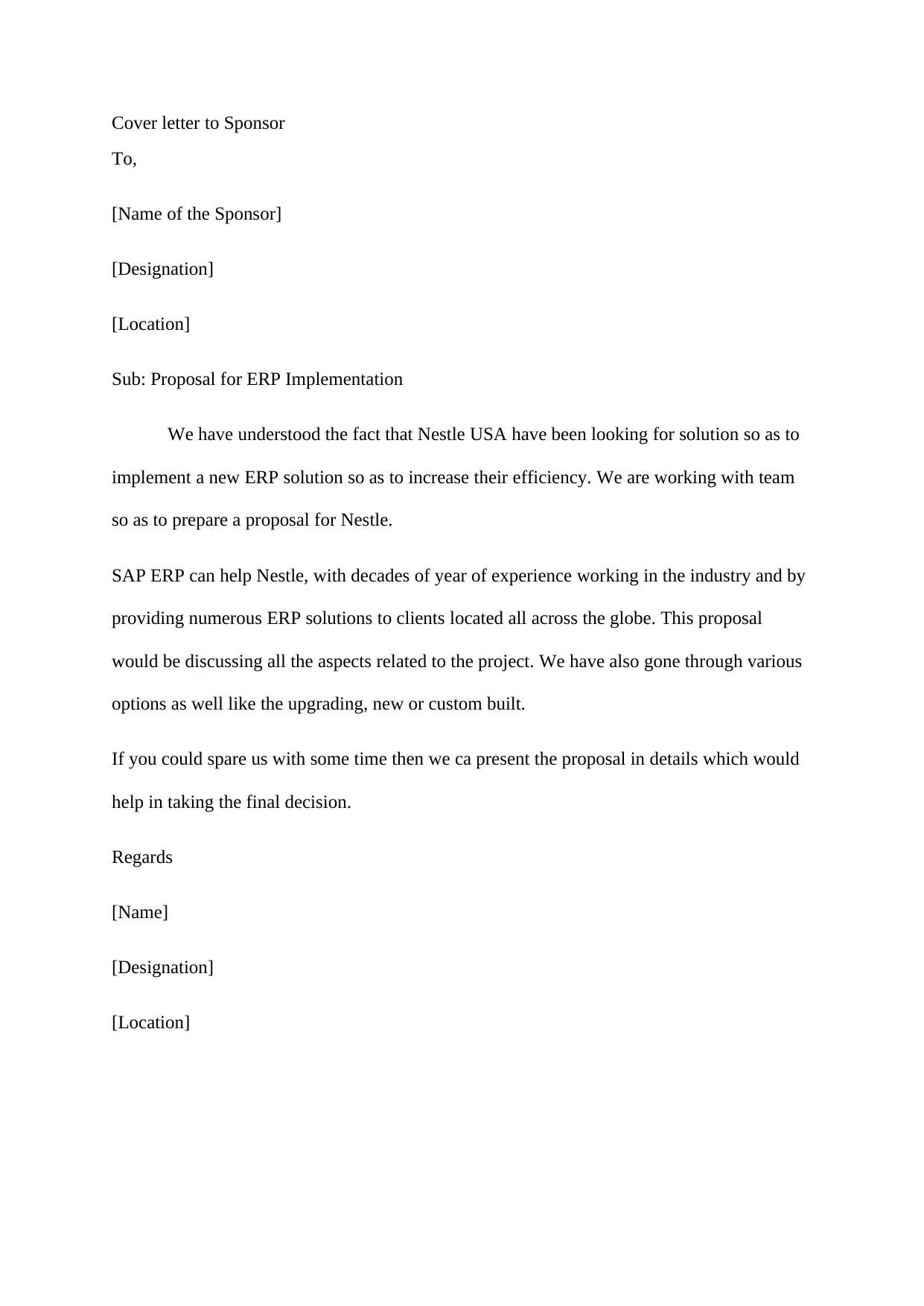
Cover letter to Sponsor
To,
[Name of the Sponsor]
[Designation]
[Location]
Sub: Proposal for ERP Implementation
We have understood the fact that Nestle USA have been looking for solution so as to
implement a new ERP solution so as to increase their efficiency. We are working with team
so as to prepare a proposal for Nestle.
SAP ERP can help Nestle, with decades of year of experience working in the industry and by
providing numerous ERP solutions to clients located all across the globe. This proposal
would be discussing all the aspects related to the project. We have also gone through various
options as well like the upgrading, new or custom built.
If you could spare us with some time then we ca present the proposal in details which would
help in taking the final decision.
Regards
[Name]
[Designation]
[Location]
To,
[Name of the Sponsor]
[Designation]
[Location]
Sub: Proposal for ERP Implementation
We have understood the fact that Nestle USA have been looking for solution so as to
implement a new ERP solution so as to increase their efficiency. We are working with team
so as to prepare a proposal for Nestle.
SAP ERP can help Nestle, with decades of year of experience working in the industry and by
providing numerous ERP solutions to clients located all across the globe. This proposal
would be discussing all the aspects related to the project. We have also gone through various
options as well like the upgrading, new or custom built.
If you could spare us with some time then we ca present the proposal in details which would
help in taking the final decision.
Regards
[Name]
[Designation]
[Location]

Executive Summary
Enterprise Resource Planning is considered to be the business process management software
which is associated with allowing the organization in using a system which consists of
integrated applications for the purpose of managing the business along with helping in the
automation of various back office functions that are related to the technology, service and the
human resources. This software is typically associated with the integration of the facets of an
organization which includes the planning, development, manufacturing, sales and many more
into a single database, application or an user interface.
The major aim of this report is to analyze the ERP system existing in the organization Nestle.
Besides this the report would be associated with discussing the implementation of the new
ERP system as well which would be helping the organization in eliminating the various type
of problems that are faced by the organization’s existing systems. The new ERP system that
is to be implemented in the organization is SAP ERP Solution. The report also consists of a
section where all the major areas that needs focus has been discussed. Besides this in the last
section of the report certain steps have been recommended that would be helping the
organization is increasing eth efficiency of the new ERP solution.
Enterprise Resource Planning is considered to be the business process management software
which is associated with allowing the organization in using a system which consists of
integrated applications for the purpose of managing the business along with helping in the
automation of various back office functions that are related to the technology, service and the
human resources. This software is typically associated with the integration of the facets of an
organization which includes the planning, development, manufacturing, sales and many more
into a single database, application or an user interface.
The major aim of this report is to analyze the ERP system existing in the organization Nestle.
Besides this the report would be associated with discussing the implementation of the new
ERP system as well which would be helping the organization in eliminating the various type
of problems that are faced by the organization’s existing systems. The new ERP system that
is to be implemented in the organization is SAP ERP Solution. The report also consists of a
section where all the major areas that needs focus has been discussed. Besides this in the last
section of the report certain steps have been recommended that would be helping the
organization is increasing eth efficiency of the new ERP solution.
⊘ This is a preview!⊘
Do you want full access?
Subscribe today to unlock all pages.

Trusted by 1+ million students worldwide

Table of Contents
Introduction:...............................................................................................................................5
Business case for an ERP:..........................................................................................................5
Previous ERP solution:..............................................................................................................6
ERP Implementation Strategy:...................................................................................................9
Results of the Implementation of the New ERP:.....................................................................12
Recommendations:...................................................................................................................13
Conclusion:..............................................................................................................................15
References:...............................................................................................................................16
Introduction:...............................................................................................................................5
Business case for an ERP:..........................................................................................................5
Previous ERP solution:..............................................................................................................6
ERP Implementation Strategy:...................................................................................................9
Results of the Implementation of the New ERP:.....................................................................12
Recommendations:...................................................................................................................13
Conclusion:..............................................................................................................................15
References:...............................................................................................................................16
Paraphrase This Document
Need a fresh take? Get an instant paraphrase of this document with our AI Paraphraser
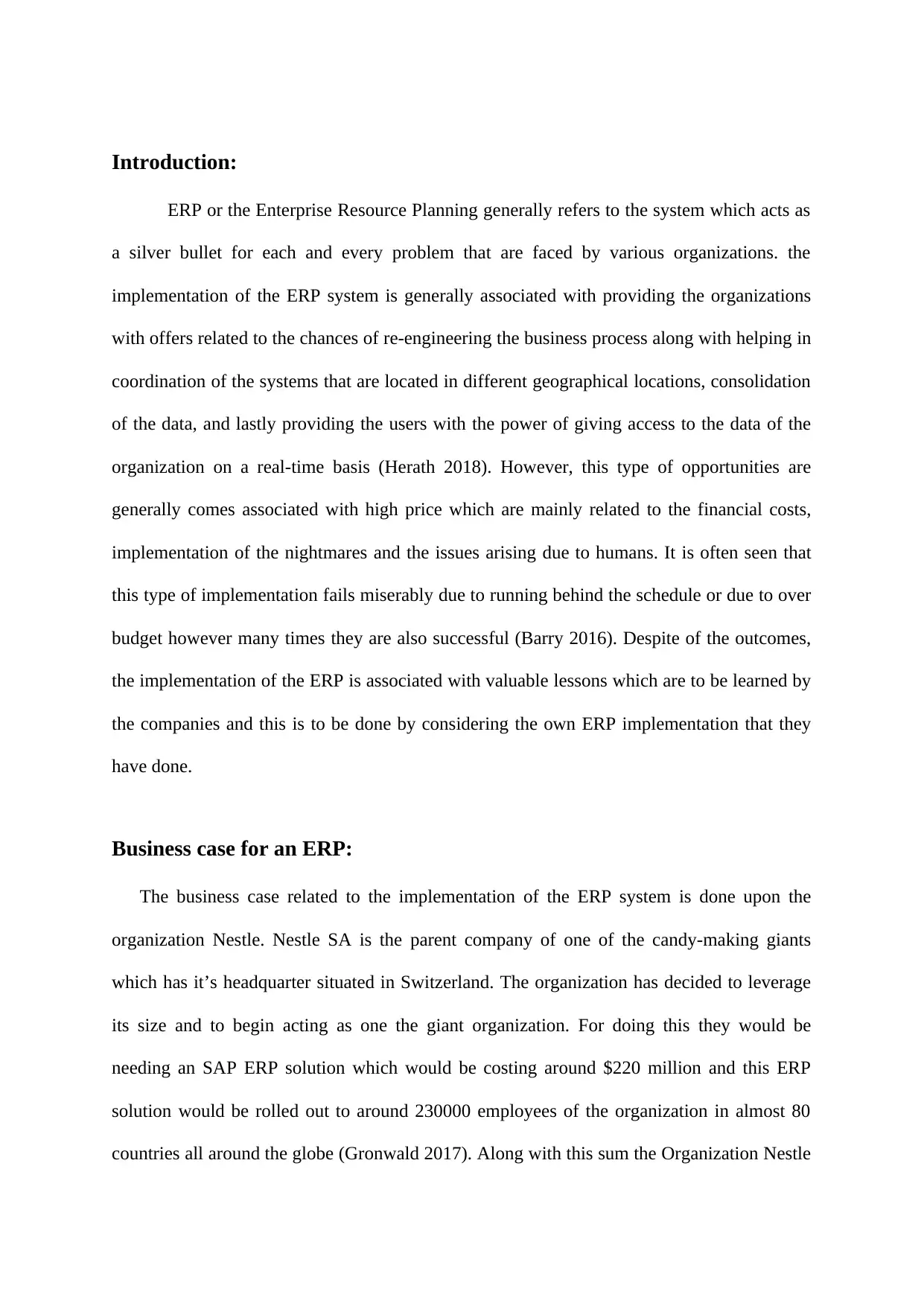
Introduction:
ERP or the Enterprise Resource Planning generally refers to the system which acts as
a silver bullet for each and every problem that are faced by various organizations. the
implementation of the ERP system is generally associated with providing the organizations
with offers related to the chances of re-engineering the business process along with helping in
coordination of the systems that are located in different geographical locations, consolidation
of the data, and lastly providing the users with the power of giving access to the data of the
organization on a real-time basis (Herath 2018). However, this type of opportunities are
generally comes associated with high price which are mainly related to the financial costs,
implementation of the nightmares and the issues arising due to humans. It is often seen that
this type of implementation fails miserably due to running behind the schedule or due to over
budget however many times they are also successful (Barry 2016). Despite of the outcomes,
the implementation of the ERP is associated with valuable lessons which are to be learned by
the companies and this is to be done by considering the own ERP implementation that they
have done.
Business case for an ERP:
The business case related to the implementation of the ERP system is done upon the
organization Nestle. Nestle SA is the parent company of one of the candy-making giants
which has it’s headquarter situated in Switzerland. The organization has decided to leverage
its size and to begin acting as one the giant organization. For doing this they would be
needing an SAP ERP solution which would be costing around $220 million and this ERP
solution would be rolled out to around 230000 employees of the organization in almost 80
countries all around the globe (Gronwald 2017). Along with this sum the Organization Nestle
ERP or the Enterprise Resource Planning generally refers to the system which acts as
a silver bullet for each and every problem that are faced by various organizations. the
implementation of the ERP system is generally associated with providing the organizations
with offers related to the chances of re-engineering the business process along with helping in
coordination of the systems that are located in different geographical locations, consolidation
of the data, and lastly providing the users with the power of giving access to the data of the
organization on a real-time basis (Herath 2018). However, this type of opportunities are
generally comes associated with high price which are mainly related to the financial costs,
implementation of the nightmares and the issues arising due to humans. It is often seen that
this type of implementation fails miserably due to running behind the schedule or due to over
budget however many times they are also successful (Barry 2016). Despite of the outcomes,
the implementation of the ERP is associated with valuable lessons which are to be learned by
the companies and this is to be done by considering the own ERP implementation that they
have done.
Business case for an ERP:
The business case related to the implementation of the ERP system is done upon the
organization Nestle. Nestle SA is the parent company of one of the candy-making giants
which has it’s headquarter situated in Switzerland. The organization has decided to leverage
its size and to begin acting as one the giant organization. For doing this they would be
needing an SAP ERP solution which would be costing around $220 million and this ERP
solution would be rolled out to around 230000 employees of the organization in almost 80
countries all around the globe (Gronwald 2017). Along with this sum the Organization Nestle
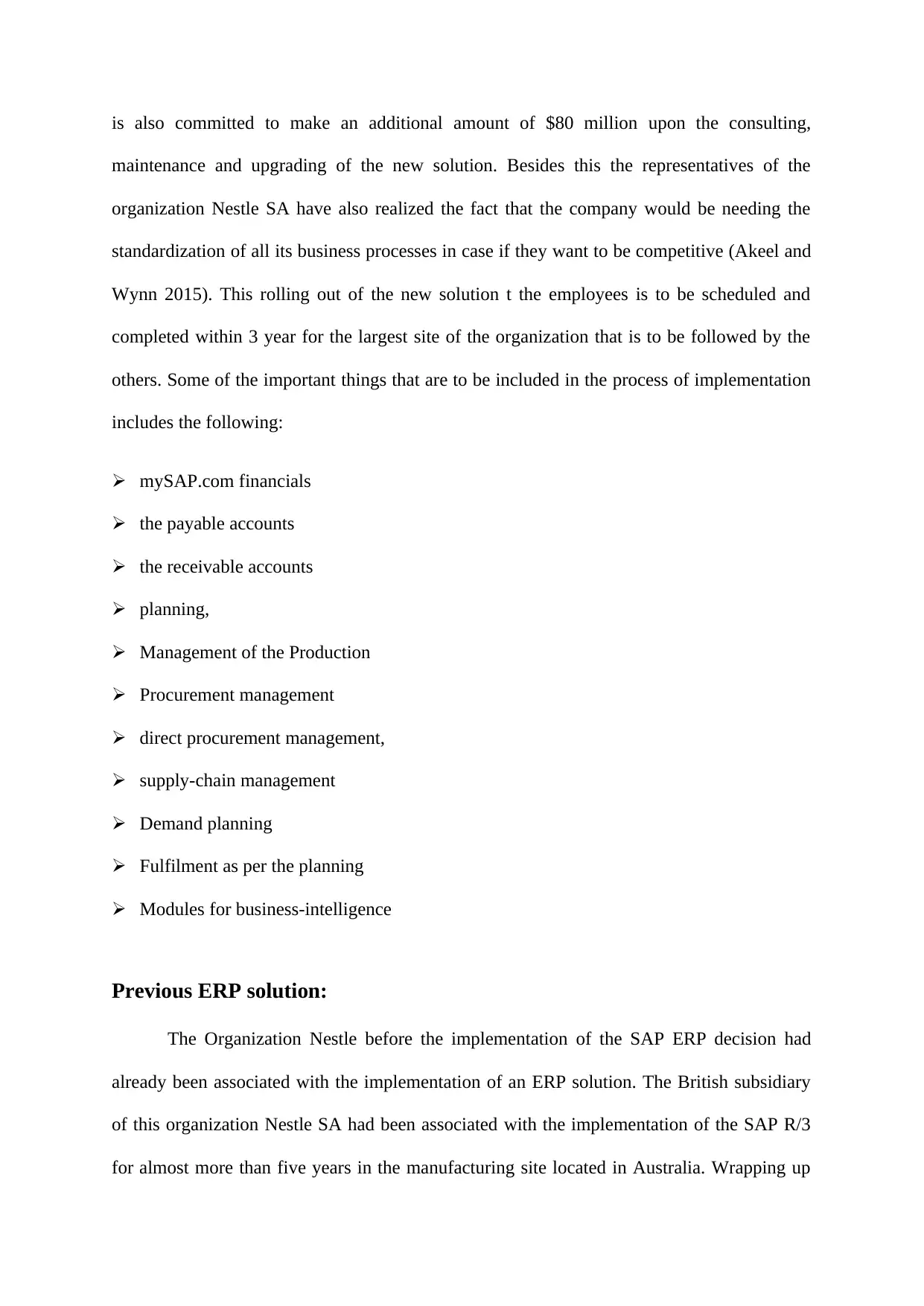
is also committed to make an additional amount of $80 million upon the consulting,
maintenance and upgrading of the new solution. Besides this the representatives of the
organization Nestle SA have also realized the fact that the company would be needing the
standardization of all its business processes in case if they want to be competitive (Akeel and
Wynn 2015). This rolling out of the new solution t the employees is to be scheduled and
completed within 3 year for the largest site of the organization that is to be followed by the
others. Some of the important things that are to be included in the process of implementation
includes the following:
mySAP.com financials
the payable accounts
the receivable accounts
planning,
Management of the Production
Procurement management
direct procurement management,
supply-chain management
Demand planning
Fulfilment as per the planning
Modules for business-intelligence
Previous ERP solution:
The Organization Nestle before the implementation of the SAP ERP decision had
already been associated with the implementation of an ERP solution. The British subsidiary
of this organization Nestle SA had been associated with the implementation of the SAP R/3
for almost more than five years in the manufacturing site located in Australia. Wrapping up
maintenance and upgrading of the new solution. Besides this the representatives of the
organization Nestle SA have also realized the fact that the company would be needing the
standardization of all its business processes in case if they want to be competitive (Akeel and
Wynn 2015). This rolling out of the new solution t the employees is to be scheduled and
completed within 3 year for the largest site of the organization that is to be followed by the
others. Some of the important things that are to be included in the process of implementation
includes the following:
mySAP.com financials
the payable accounts
the receivable accounts
planning,
Management of the Production
Procurement management
direct procurement management,
supply-chain management
Demand planning
Fulfilment as per the planning
Modules for business-intelligence
Previous ERP solution:
The Organization Nestle before the implementation of the SAP ERP decision had
already been associated with the implementation of an ERP solution. The British subsidiary
of this organization Nestle SA had been associated with the implementation of the SAP R/3
for almost more than five years in the manufacturing site located in Australia. Wrapping up
⊘ This is a preview!⊘
Do you want full access?
Subscribe today to unlock all pages.

Trusted by 1+ million students worldwide
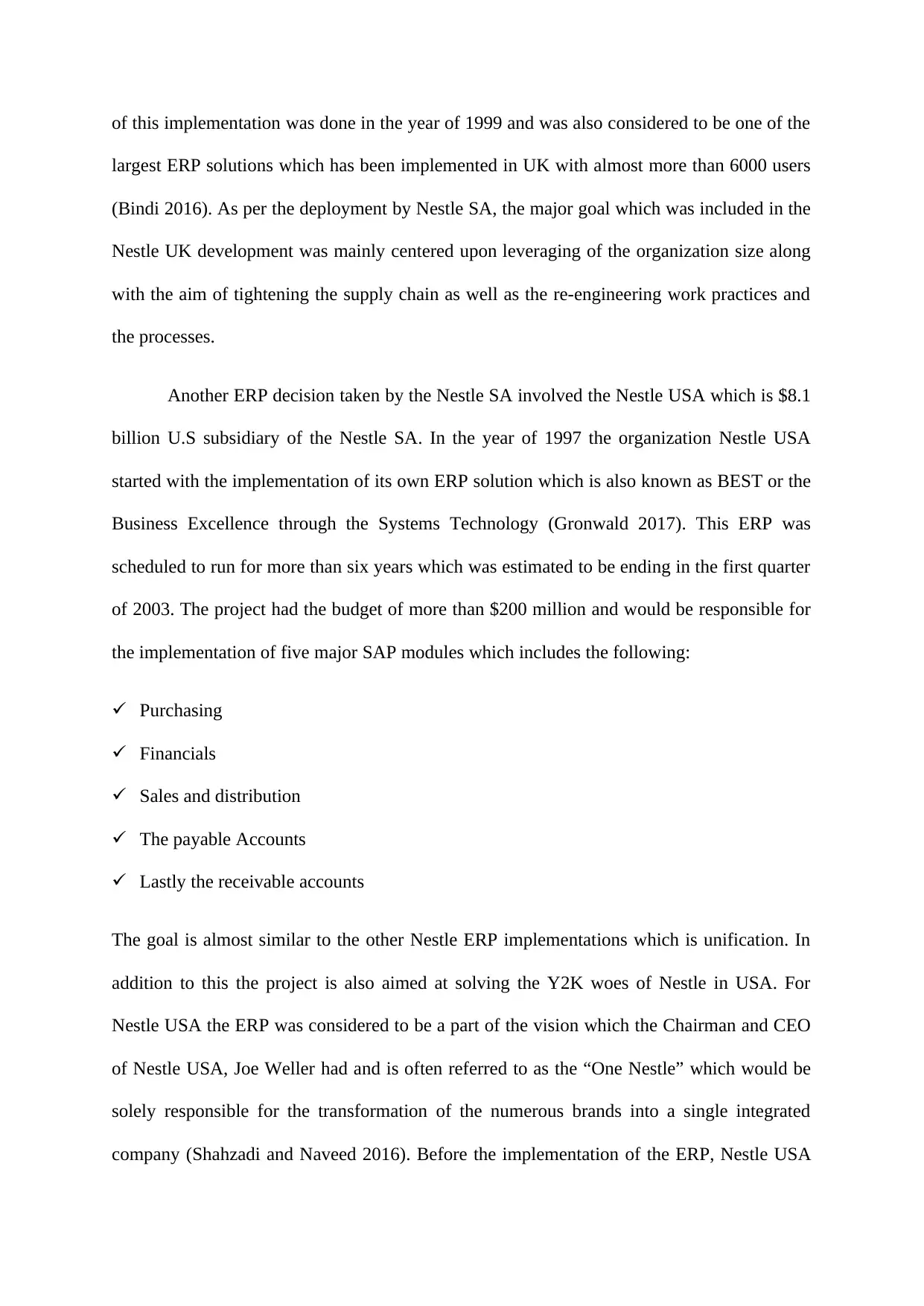
of this implementation was done in the year of 1999 and was also considered to be one of the
largest ERP solutions which has been implemented in UK with almost more than 6000 users
(Bindi 2016). As per the deployment by Nestle SA, the major goal which was included in the
Nestle UK development was mainly centered upon leveraging of the organization size along
with the aim of tightening the supply chain as well as the re-engineering work practices and
the processes.
Another ERP decision taken by the Nestle SA involved the Nestle USA which is $8.1
billion U.S subsidiary of the Nestle SA. In the year of 1997 the organization Nestle USA
started with the implementation of its own ERP solution which is also known as BEST or the
Business Excellence through the Systems Technology (Gronwald 2017). This ERP was
scheduled to run for more than six years which was estimated to be ending in the first quarter
of 2003. The project had the budget of more than $200 million and would be responsible for
the implementation of five major SAP modules which includes the following:
Purchasing
Financials
Sales and distribution
The payable Accounts
Lastly the receivable accounts
The goal is almost similar to the other Nestle ERP implementations which is unification. In
addition to this the project is also aimed at solving the Y2K woes of Nestle in USA. For
Nestle USA the ERP was considered to be a part of the vision which the Chairman and CEO
of Nestle USA, Joe Weller had and is often referred to as the “One Nestle” which would be
solely responsible for the transformation of the numerous brands into a single integrated
company (Shahzadi and Naveed 2016). Before the implementation of the ERP, Nestle USA
largest ERP solutions which has been implemented in UK with almost more than 6000 users
(Bindi 2016). As per the deployment by Nestle SA, the major goal which was included in the
Nestle UK development was mainly centered upon leveraging of the organization size along
with the aim of tightening the supply chain as well as the re-engineering work practices and
the processes.
Another ERP decision taken by the Nestle SA involved the Nestle USA which is $8.1
billion U.S subsidiary of the Nestle SA. In the year of 1997 the organization Nestle USA
started with the implementation of its own ERP solution which is also known as BEST or the
Business Excellence through the Systems Technology (Gronwald 2017). This ERP was
scheduled to run for more than six years which was estimated to be ending in the first quarter
of 2003. The project had the budget of more than $200 million and would be responsible for
the implementation of five major SAP modules which includes the following:
Purchasing
Financials
Sales and distribution
The payable Accounts
Lastly the receivable accounts
The goal is almost similar to the other Nestle ERP implementations which is unification. In
addition to this the project is also aimed at solving the Y2K woes of Nestle in USA. For
Nestle USA the ERP was considered to be a part of the vision which the Chairman and CEO
of Nestle USA, Joe Weller had and is often referred to as the “One Nestle” which would be
solely responsible for the transformation of the numerous brands into a single integrated
company (Shahzadi and Naveed 2016). Before the implementation of the ERP, Nestle USA
Paraphrase This Document
Need a fresh take? Get an instant paraphrase of this document with our AI Paraphraser
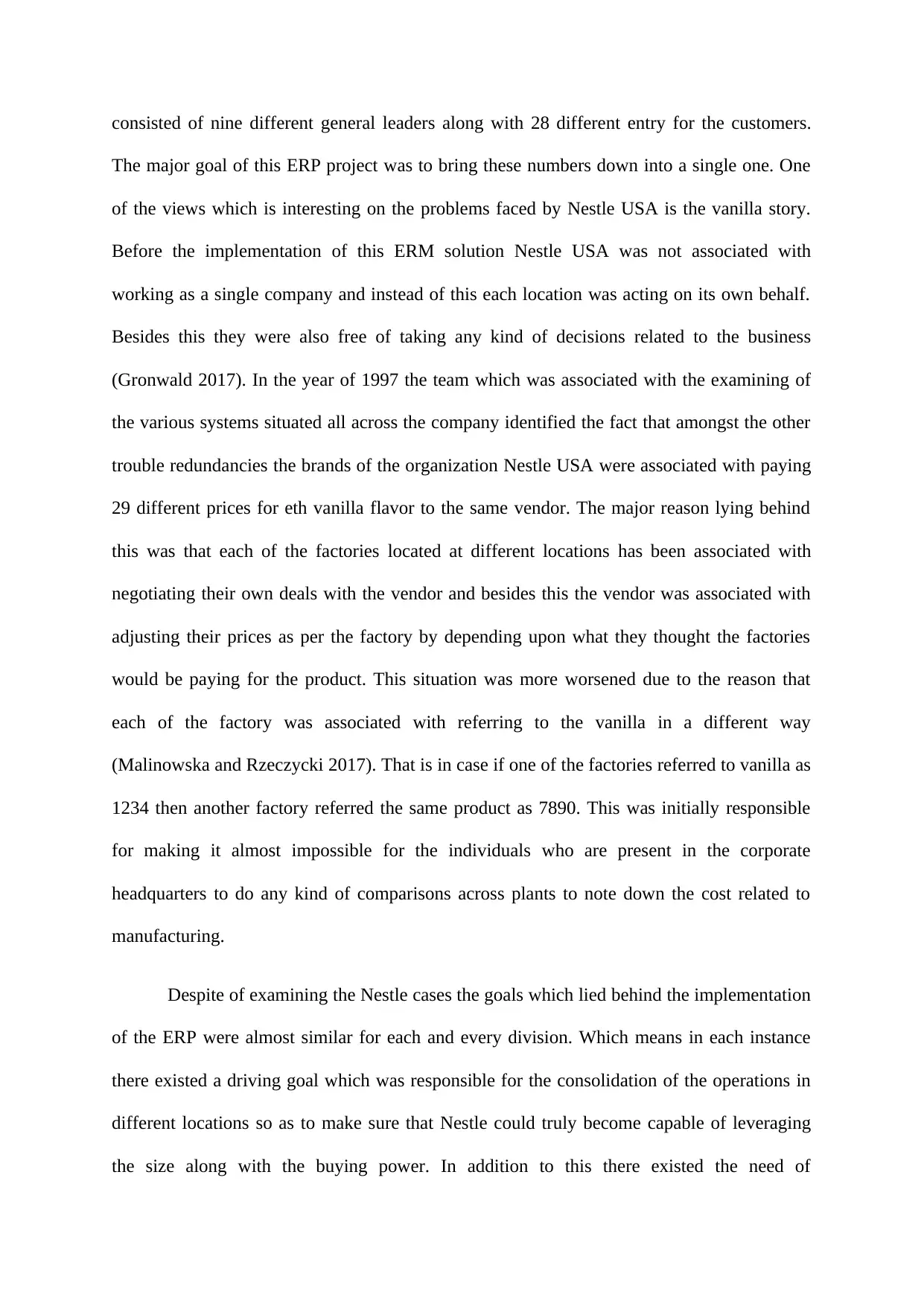
consisted of nine different general leaders along with 28 different entry for the customers.
The major goal of this ERP project was to bring these numbers down into a single one. One
of the views which is interesting on the problems faced by Nestle USA is the vanilla story.
Before the implementation of this ERM solution Nestle USA was not associated with
working as a single company and instead of this each location was acting on its own behalf.
Besides this they were also free of taking any kind of decisions related to the business
(Gronwald 2017). In the year of 1997 the team which was associated with the examining of
the various systems situated all across the company identified the fact that amongst the other
trouble redundancies the brands of the organization Nestle USA were associated with paying
29 different prices for eth vanilla flavor to the same vendor. The major reason lying behind
this was that each of the factories located at different locations has been associated with
negotiating their own deals with the vendor and besides this the vendor was associated with
adjusting their prices as per the factory by depending upon what they thought the factories
would be paying for the product. This situation was more worsened due to the reason that
each of the factory was associated with referring to the vanilla in a different way
(Malinowska and Rzeczycki 2017). That is in case if one of the factories referred to vanilla as
1234 then another factory referred the same product as 7890. This was initially responsible
for making it almost impossible for the individuals who are present in the corporate
headquarters to do any kind of comparisons across plants to note down the cost related to
manufacturing.
Despite of examining the Nestle cases the goals which lied behind the implementation
of the ERP were almost similar for each and every division. Which means in each instance
there existed a driving goal which was responsible for the consolidation of the operations in
different locations so as to make sure that Nestle could truly become capable of leveraging
the size along with the buying power. In addition to this there existed the need of
The major goal of this ERP project was to bring these numbers down into a single one. One
of the views which is interesting on the problems faced by Nestle USA is the vanilla story.
Before the implementation of this ERM solution Nestle USA was not associated with
working as a single company and instead of this each location was acting on its own behalf.
Besides this they were also free of taking any kind of decisions related to the business
(Gronwald 2017). In the year of 1997 the team which was associated with the examining of
the various systems situated all across the company identified the fact that amongst the other
trouble redundancies the brands of the organization Nestle USA were associated with paying
29 different prices for eth vanilla flavor to the same vendor. The major reason lying behind
this was that each of the factories located at different locations has been associated with
negotiating their own deals with the vendor and besides this the vendor was associated with
adjusting their prices as per the factory by depending upon what they thought the factories
would be paying for the product. This situation was more worsened due to the reason that
each of the factory was associated with referring to the vanilla in a different way
(Malinowska and Rzeczycki 2017). That is in case if one of the factories referred to vanilla as
1234 then another factory referred the same product as 7890. This was initially responsible
for making it almost impossible for the individuals who are present in the corporate
headquarters to do any kind of comparisons across plants to note down the cost related to
manufacturing.
Despite of examining the Nestle cases the goals which lied behind the implementation
of the ERP were almost similar for each and every division. Which means in each instance
there existed a driving goal which was responsible for the consolidation of the operations in
different locations so as to make sure that Nestle could truly become capable of leveraging
the size along with the buying power. In addition to this there existed the need of
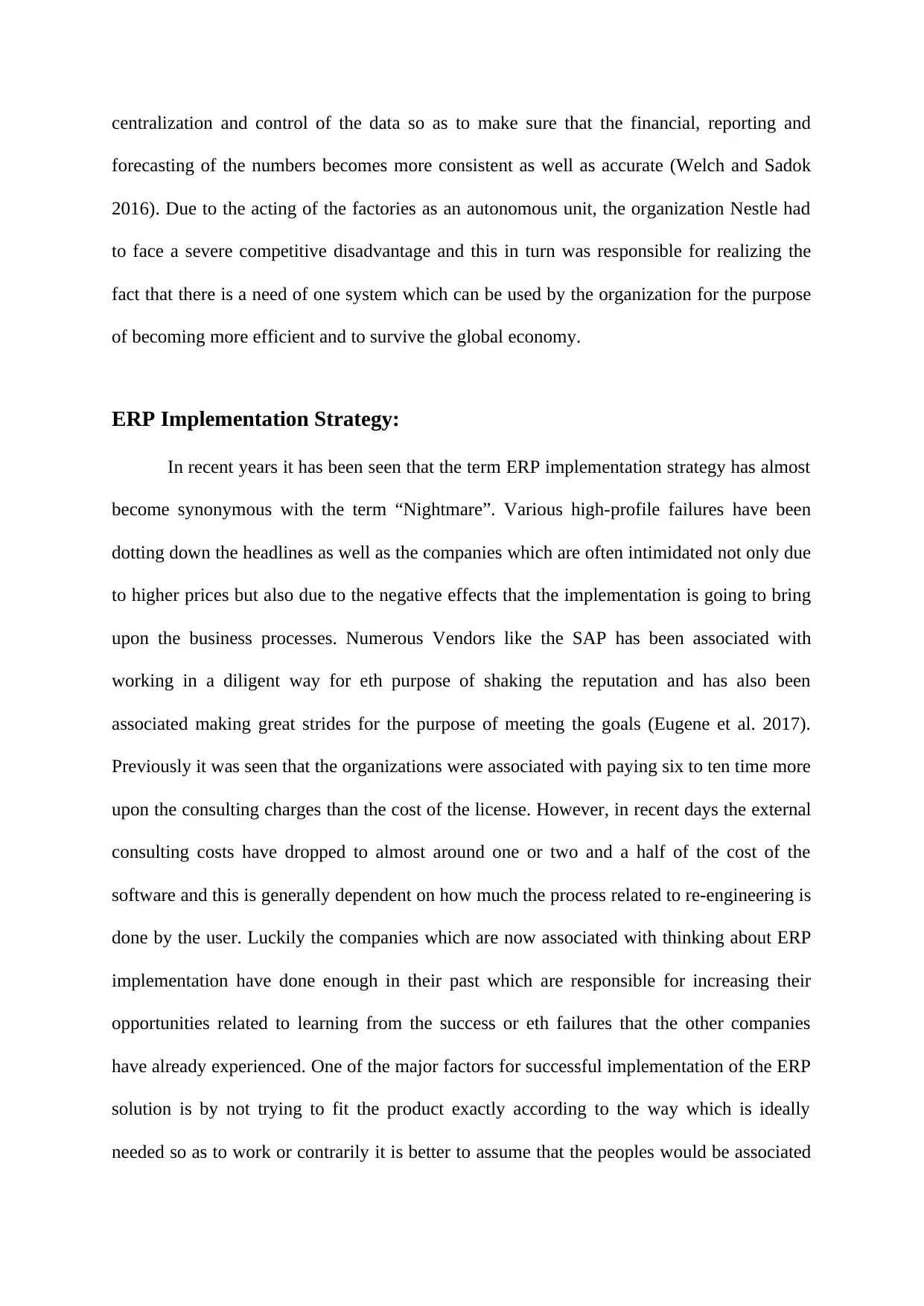
centralization and control of the data so as to make sure that the financial, reporting and
forecasting of the numbers becomes more consistent as well as accurate (Welch and Sadok
2016). Due to the acting of the factories as an autonomous unit, the organization Nestle had
to face a severe competitive disadvantage and this in turn was responsible for realizing the
fact that there is a need of one system which can be used by the organization for the purpose
of becoming more efficient and to survive the global economy.
ERP Implementation Strategy:
In recent years it has been seen that the term ERP implementation strategy has almost
become synonymous with the term “Nightmare”. Various high-profile failures have been
dotting down the headlines as well as the companies which are often intimidated not only due
to higher prices but also due to the negative effects that the implementation is going to bring
upon the business processes. Numerous Vendors like the SAP has been associated with
working in a diligent way for eth purpose of shaking the reputation and has also been
associated making great strides for the purpose of meeting the goals (Eugene et al. 2017).
Previously it was seen that the organizations were associated with paying six to ten time more
upon the consulting charges than the cost of the license. However, in recent days the external
consulting costs have dropped to almost around one or two and a half of the cost of the
software and this is generally dependent on how much the process related to re-engineering is
done by the user. Luckily the companies which are now associated with thinking about ERP
implementation have done enough in their past which are responsible for increasing their
opportunities related to learning from the success or eth failures that the other companies
have already experienced. One of the major factors for successful implementation of the ERP
solution is by not trying to fit the product exactly according to the way which is ideally
needed so as to work or contrarily it is better to assume that the peoples would be associated
forecasting of the numbers becomes more consistent as well as accurate (Welch and Sadok
2016). Due to the acting of the factories as an autonomous unit, the organization Nestle had
to face a severe competitive disadvantage and this in turn was responsible for realizing the
fact that there is a need of one system which can be used by the organization for the purpose
of becoming more efficient and to survive the global economy.
ERP Implementation Strategy:
In recent years it has been seen that the term ERP implementation strategy has almost
become synonymous with the term “Nightmare”. Various high-profile failures have been
dotting down the headlines as well as the companies which are often intimidated not only due
to higher prices but also due to the negative effects that the implementation is going to bring
upon the business processes. Numerous Vendors like the SAP has been associated with
working in a diligent way for eth purpose of shaking the reputation and has also been
associated making great strides for the purpose of meeting the goals (Eugene et al. 2017).
Previously it was seen that the organizations were associated with paying six to ten time more
upon the consulting charges than the cost of the license. However, in recent days the external
consulting costs have dropped to almost around one or two and a half of the cost of the
software and this is generally dependent on how much the process related to re-engineering is
done by the user. Luckily the companies which are now associated with thinking about ERP
implementation have done enough in their past which are responsible for increasing their
opportunities related to learning from the success or eth failures that the other companies
have already experienced. One of the major factors for successful implementation of the ERP
solution is by not trying to fit the product exactly according to the way which is ideally
needed so as to work or contrarily it is better to assume that the peoples would be associated
⊘ This is a preview!⊘
Do you want full access?
Subscribe today to unlock all pages.

Trusted by 1+ million students worldwide
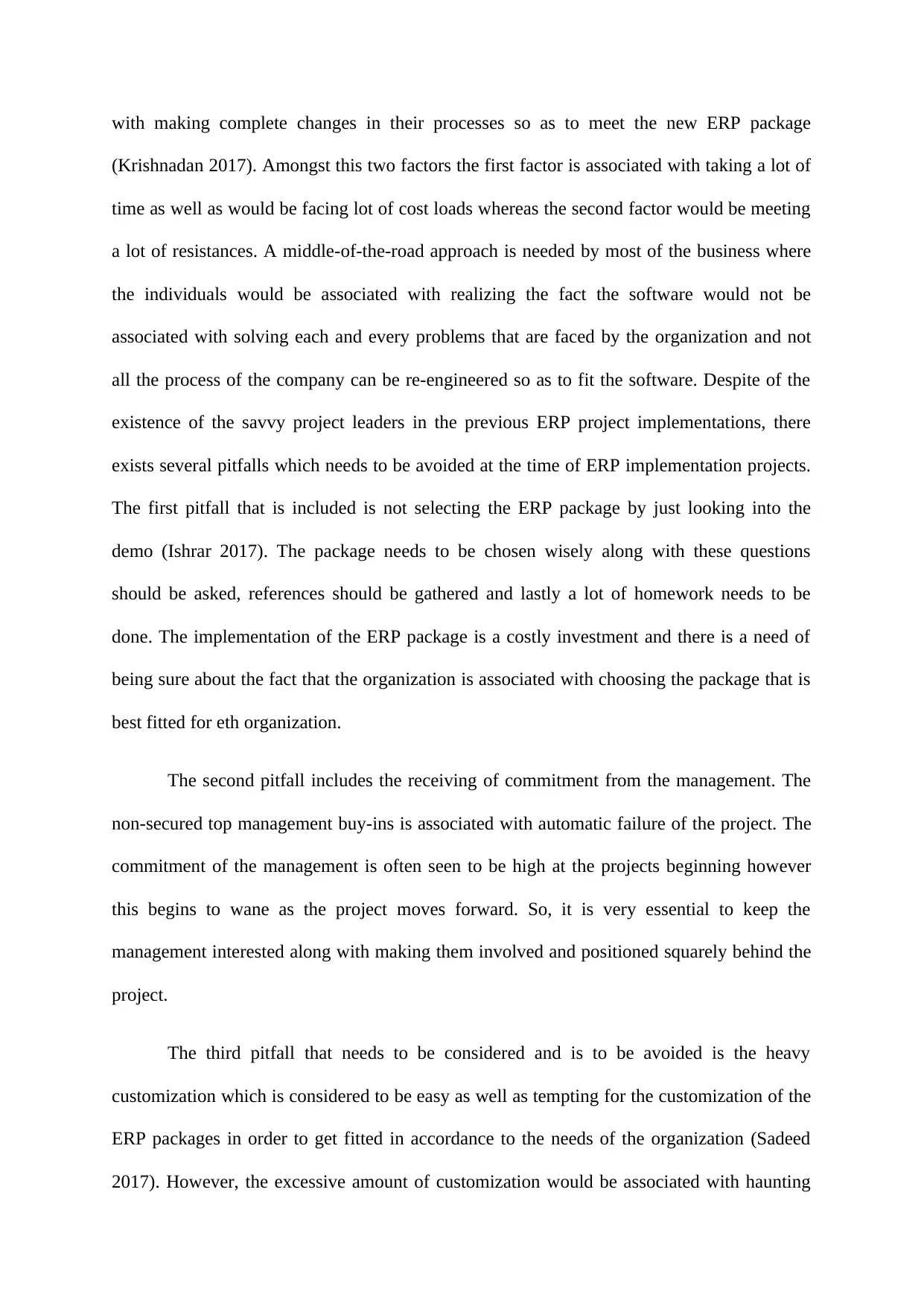
with making complete changes in their processes so as to meet the new ERP package
(Krishnadan 2017). Amongst this two factors the first factor is associated with taking a lot of
time as well as would be facing lot of cost loads whereas the second factor would be meeting
a lot of resistances. A middle-of-the-road approach is needed by most of the business where
the individuals would be associated with realizing the fact the software would not be
associated with solving each and every problems that are faced by the organization and not
all the process of the company can be re-engineered so as to fit the software. Despite of the
existence of the savvy project leaders in the previous ERP project implementations, there
exists several pitfalls which needs to be avoided at the time of ERP implementation projects.
The first pitfall that is included is not selecting the ERP package by just looking into the
demo (Ishrar 2017). The package needs to be chosen wisely along with these questions
should be asked, references should be gathered and lastly a lot of homework needs to be
done. The implementation of the ERP package is a costly investment and there is a need of
being sure about the fact that the organization is associated with choosing the package that is
best fitted for eth organization.
The second pitfall includes the receiving of commitment from the management. The
non-secured top management buy-ins is associated with automatic failure of the project. The
commitment of the management is often seen to be high at the projects beginning however
this begins to wane as the project moves forward. So, it is very essential to keep the
management interested along with making them involved and positioned squarely behind the
project.
The third pitfall that needs to be considered and is to be avoided is the heavy
customization which is considered to be easy as well as tempting for the customization of the
ERP packages in order to get fitted in accordance to the needs of the organization (Sadeed
2017). However, the excessive amount of customization would be associated with haunting
(Krishnadan 2017). Amongst this two factors the first factor is associated with taking a lot of
time as well as would be facing lot of cost loads whereas the second factor would be meeting
a lot of resistances. A middle-of-the-road approach is needed by most of the business where
the individuals would be associated with realizing the fact the software would not be
associated with solving each and every problems that are faced by the organization and not
all the process of the company can be re-engineered so as to fit the software. Despite of the
existence of the savvy project leaders in the previous ERP project implementations, there
exists several pitfalls which needs to be avoided at the time of ERP implementation projects.
The first pitfall that is included is not selecting the ERP package by just looking into the
demo (Ishrar 2017). The package needs to be chosen wisely along with these questions
should be asked, references should be gathered and lastly a lot of homework needs to be
done. The implementation of the ERP package is a costly investment and there is a need of
being sure about the fact that the organization is associated with choosing the package that is
best fitted for eth organization.
The second pitfall includes the receiving of commitment from the management. The
non-secured top management buy-ins is associated with automatic failure of the project. The
commitment of the management is often seen to be high at the projects beginning however
this begins to wane as the project moves forward. So, it is very essential to keep the
management interested along with making them involved and positioned squarely behind the
project.
The third pitfall that needs to be considered and is to be avoided is the heavy
customization which is considered to be easy as well as tempting for the customization of the
ERP packages in order to get fitted in accordance to the needs of the organization (Sadeed
2017). However, the excessive amount of customization would be associated with haunting
Paraphrase This Document
Need a fresh take? Get an instant paraphrase of this document with our AI Paraphraser

the organization by means of lengthening the timeline of the project and by driving the
maintenance cost that are likely to be needed in the future.
The last pitfall that is to be considered and avoided is the underestimating the
importance that the training programs are having. This is not very uncommon that the users
are associated with receiving of several days of training for using the new system which is
followed by not seeing the system for months (Thankdenchai and Pasawat 2015). There is a
need of in-depth along with on-going training by the users and besides this the users should
even be involved in testing the system if it is at all possible.
However, Nestle USA was not associated with heeding the failures experienced by
others. Nestle USA was associated with making a lot of mistakes throughout the
implementation process which were almost responsible for dooming of the project. At the
beginning of the project a team was created which consisted of 5o top executives along with
10 senior IT professions who were assembled for the purpose of developing the set of best
practices for all the divisions of the organization (Mitra, O'Regan and Sarpong 2018). The
goal mainly included the development of the best practices for the different operations of the
business. Each of the functions would be eventually forced to have retirement of the old
approaches which is to be followed by adaptation of the new best practices which are to be
developed. Besides this another major reason for turning of the previous solutions into a
complete disaster was not understanding the system by the employees along with not
understanding the new work processes as well for which they were being forced in order to
be adopted (Bhattacharya 2016). Besides the divisional executives were totally confused and
the major reason behind this was that they had been left out of the planning and development
of the ne system and this in turn was responsible for making them loose their will to assist the
new system in straightening out the numerous messes which has developed. This initially
resulted in the palmation of the morals and the skyrocketing of the turnovers.
maintenance cost that are likely to be needed in the future.
The last pitfall that is to be considered and avoided is the underestimating the
importance that the training programs are having. This is not very uncommon that the users
are associated with receiving of several days of training for using the new system which is
followed by not seeing the system for months (Thankdenchai and Pasawat 2015). There is a
need of in-depth along with on-going training by the users and besides this the users should
even be involved in testing the system if it is at all possible.
However, Nestle USA was not associated with heeding the failures experienced by
others. Nestle USA was associated with making a lot of mistakes throughout the
implementation process which were almost responsible for dooming of the project. At the
beginning of the project a team was created which consisted of 5o top executives along with
10 senior IT professions who were assembled for the purpose of developing the set of best
practices for all the divisions of the organization (Mitra, O'Regan and Sarpong 2018). The
goal mainly included the development of the best practices for the different operations of the
business. Each of the functions would be eventually forced to have retirement of the old
approaches which is to be followed by adaptation of the new best practices which are to be
developed. Besides this another major reason for turning of the previous solutions into a
complete disaster was not understanding the system by the employees along with not
understanding the new work processes as well for which they were being forced in order to
be adopted (Bhattacharya 2016). Besides the divisional executives were totally confused and
the major reason behind this was that they had been left out of the planning and development
of the ne system and this in turn was responsible for making them loose their will to assist the
new system in straightening out the numerous messes which has developed. This initially
resulted in the palmation of the morals and the skyrocketing of the turnovers.
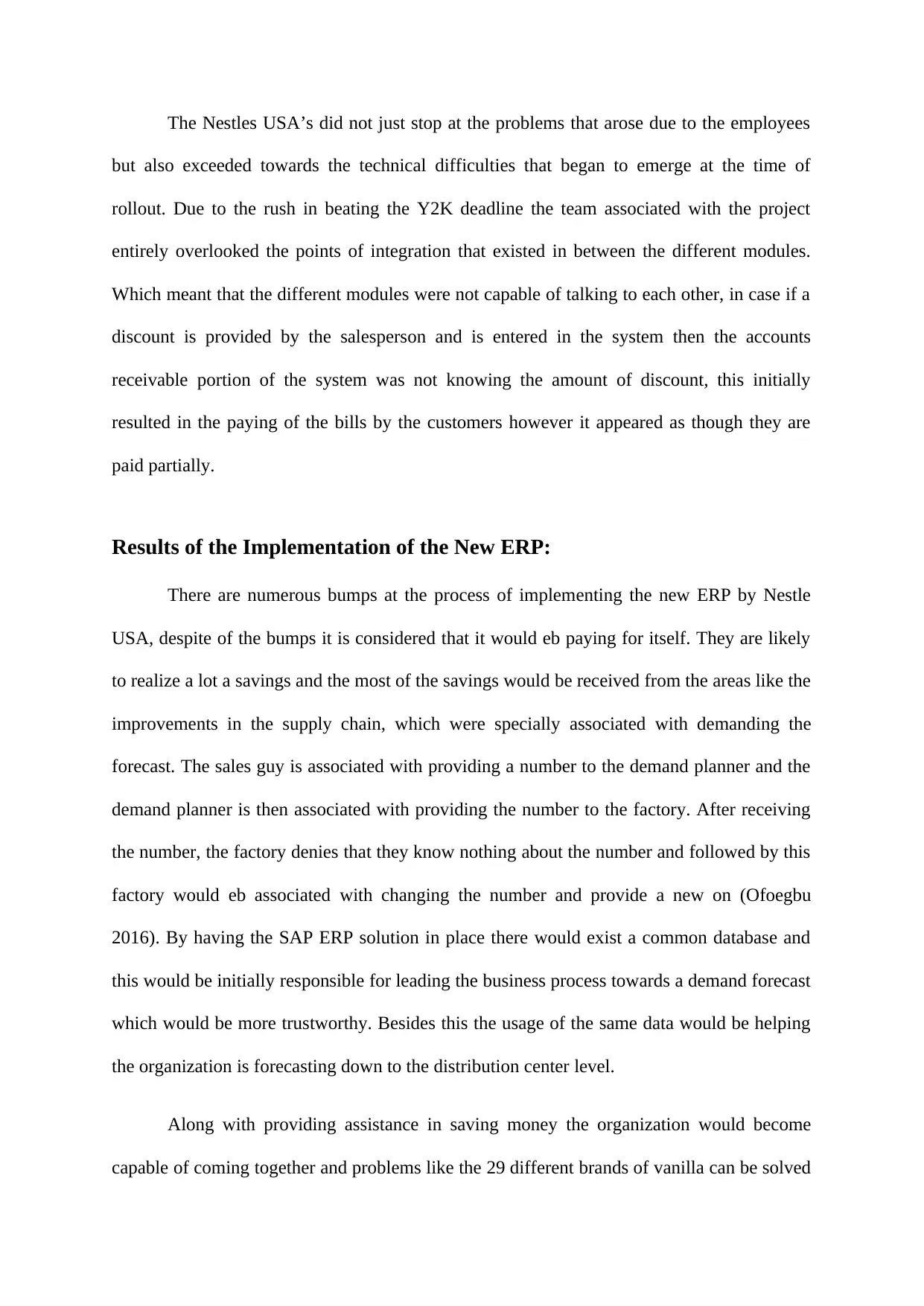
The Nestles USA’s did not just stop at the problems that arose due to the employees
but also exceeded towards the technical difficulties that began to emerge at the time of
rollout. Due to the rush in beating the Y2K deadline the team associated with the project
entirely overlooked the points of integration that existed in between the different modules.
Which meant that the different modules were not capable of talking to each other, in case if a
discount is provided by the salesperson and is entered in the system then the accounts
receivable portion of the system was not knowing the amount of discount, this initially
resulted in the paying of the bills by the customers however it appeared as though they are
paid partially.
Results of the Implementation of the New ERP:
There are numerous bumps at the process of implementing the new ERP by Nestle
USA, despite of the bumps it is considered that it would eb paying for itself. They are likely
to realize a lot a savings and the most of the savings would be received from the areas like the
improvements in the supply chain, which were specially associated with demanding the
forecast. The sales guy is associated with providing a number to the demand planner and the
demand planner is then associated with providing the number to the factory. After receiving
the number, the factory denies that they know nothing about the number and followed by this
factory would eb associated with changing the number and provide a new on (Ofoegbu
2016). By having the SAP ERP solution in place there would exist a common database and
this would be initially responsible for leading the business process towards a demand forecast
which would be more trustworthy. Besides this the usage of the same data would be helping
the organization is forecasting down to the distribution center level.
Along with providing assistance in saving money the organization would become
capable of coming together and problems like the 29 different brands of vanilla can be solved
but also exceeded towards the technical difficulties that began to emerge at the time of
rollout. Due to the rush in beating the Y2K deadline the team associated with the project
entirely overlooked the points of integration that existed in between the different modules.
Which meant that the different modules were not capable of talking to each other, in case if a
discount is provided by the salesperson and is entered in the system then the accounts
receivable portion of the system was not knowing the amount of discount, this initially
resulted in the paying of the bills by the customers however it appeared as though they are
paid partially.
Results of the Implementation of the New ERP:
There are numerous bumps at the process of implementing the new ERP by Nestle
USA, despite of the bumps it is considered that it would eb paying for itself. They are likely
to realize a lot a savings and the most of the savings would be received from the areas like the
improvements in the supply chain, which were specially associated with demanding the
forecast. The sales guy is associated with providing a number to the demand planner and the
demand planner is then associated with providing the number to the factory. After receiving
the number, the factory denies that they know nothing about the number and followed by this
factory would eb associated with changing the number and provide a new on (Ofoegbu
2016). By having the SAP ERP solution in place there would exist a common database and
this would be initially responsible for leading the business process towards a demand forecast
which would be more trustworthy. Besides this the usage of the same data would be helping
the organization is forecasting down to the distribution center level.
Along with providing assistance in saving money the organization would become
capable of coming together and problems like the 29 different brands of vanilla can be solved
⊘ This is a preview!⊘
Do you want full access?
Subscribe today to unlock all pages.

Trusted by 1+ million students worldwide
1 out of 20
Related Documents
Your All-in-One AI-Powered Toolkit for Academic Success.
+13062052269
info@desklib.com
Available 24*7 on WhatsApp / Email
![[object Object]](/_next/static/media/star-bottom.7253800d.svg)
Unlock your academic potential
Copyright © 2020–2025 A2Z Services. All Rights Reserved. Developed and managed by ZUCOL.





